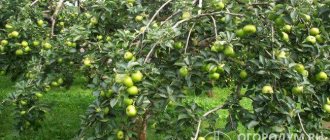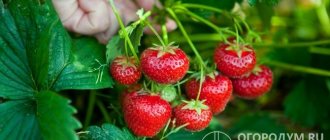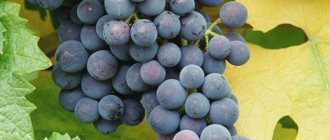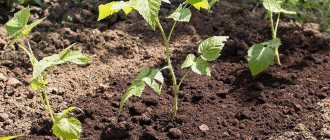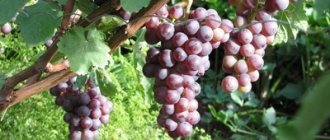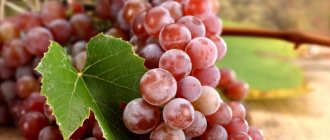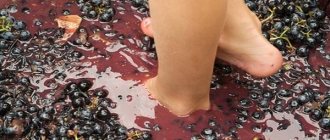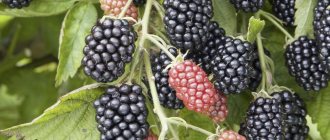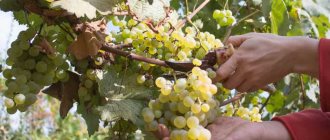Advantages and disadvantages
Like any other variety, “Arcadia” has its advantages and disadvantages.
Pros:
- Frost resistance.
- High yield.
- Early ripeness.
- Transportability.
- Mildew resistance.
- Attractive appearance.
- Bisexuality.
Minuses:
- Sensitivity to soil moisture.
- Susceptibility to gray rot and oidium.
- The need for rationing.
- Tendency to peas.
- Intolerance to cold winds.
Origin
The hybrid was developed back in Soviet times. Its creators are Ukrainian breeders from the Institute of Viticulture and Winemaking named after V.E. Tairov, who crossed the varieties “Moldova” and “Cardinal”. Despite the fact that both “parents” have dark skin, “Arcadia” turned out to be light.
Parents of “Arcadia” are “Moldova” and “Cardinal”
But she inherited their best qualities - resistance to climate change and high quality berries. It is worth noting that the parent pair “Moldova” - “Cardinal” gave rise to several more varieties of the crop, but “Arcadia” is rightfully considered the pearl of this collection.
The variety is a table variety and is widely used for industrial breeding. The fruits are an excellent raw material for the production of juices and dessert wines. They are also often sold fresh.
The plant is quite resistant to mildew - 2-3 points. However, there is no immunity to other fungal diseases. Thanks to its properties, “arcadia” is known far beyond its homeland - today it is grown in huge plantations not only in Russia and Ukraine, but also in Europe. More details about the system of resistance of varieties to diseases and pests can be found in a separate article.
How to properly care for Arcadia?
We recommend reading our other articles
- Tourist breakfast
- Horse management
- How to plant grapes from cuttings
- Carrot variety Tushon
Grapes of this variety always please gardeners with high yields, but they also require a lot of attention. Caring for it is difficult, but this is the only way to get the desired berries.
- Abundant watering is required only before flowering begins, then it is reduced.
- Fertilizing of Arcadia grapes is carried out several times a year with phosphorus-potassium and nitrogen substances. It is very important to follow the dosage!
- Pruning is a mandatory annual process. You can even carry it out 2 times a year - in autumn and spring. This is done due to the rapid growth of the vine - only by controlling its branching can you get good grapes.
- Preventive spraying against diseases and pests is carried out 2 times a year (but not during flowering or brush development).
Main characteristics
The variety is considered one of the most suitable for sale: it produces high yields, tolerates transportation well and, thanks to its excellent taste, is in demand among consumers.
Ripening period
“Arcadia” is an early ripening variety. From the moment the buds open until the first harvest is harvested, only 110-120 days pass. However, this period may vary depending on the region of growth. In central Russia, the berries ripen by early August, in the southern regions - a little earlier.
Bush
Fast-growing large Arcadia bushes can reach 2-2.5 meters in height. Among the vines, 60-70% are fruitful. The leaves of the plant are large, wide, light emerald green with a slight whitish sheen. They are cut into 5 parts and have an edge on the reverse side.
The flowers are bisexual, so the plant can pollinate itself, as well as other varieties growing nearby. Grape growers recommend using it to fertilize “lora”, “talisman”, “keshi” and many other varieties.
Bunches
Arcadia brushes are predominantly conical in shape. They are characterized by medium density and strong branching. The average weight of the bunches varies from 500 to 700 g. Although, if agricultural techniques are followed, larger specimens can be obtained - up to 2.5 kg. Sometimes they grow so huge that it can be difficult for an adult to hold them in outstretched arms.
Berries and taste
The variety is distinguished by very large fruits, on average they are about the size of a five-ruble coin:
- Length - 2.4-2.7 cm.
- Width - 2-2.5 cm.
- Weight - 12-15 g.
The fruits are round, ovoid and heart-shaped. Their color depends on the degree of ripeness: at technical level, the skin of the berries is white or light yellow; with biological - honey-amber. The skin of the berries is dense, but thin and covered with a light whitish waxy coating. It is not felt when used.
The pulp is juicy, fleshy and sweet. Its taste is very harmonious due to the combination of medium sugar content (14-16%) and low acidity (6 g/l). When fully ripe, the fruits acquire a nutmeg aroma.
Productivity
The time to obtain the first harvest depends on the planting method. If cuttings were used, then in the second year the bush will produce only signal clusters. It is recommended to leave no more than 2 of them, so as not to overload the young plant. A full harvest can be harvested next season. If the grapes were planted through grafting, the berries will ripen in the 2nd year.
In general, the yield of “Arcadia” is high - the average is 30 kg of berries per bush. However, in good years you can get up to 50 kg from each plant.
Varieties
Reference! “Arcadia” has two varieties - “pink arcadia” and “early arcadia”. Each of them has its own distinctive features.
“Arcadia pink” has pinkish-purple berries with a richer taste than the original. But its fruits and fruits are smaller and ripen 10-15 days later. The advantages of this variety include the absence of cracking due to changes in humidity.
“Arcadia early” has an accelerated ripening period. It is only 110 days. The variety is also resistant to oidium and is less attractive to wasps than the classic “Arcadia”. The disadvantages include lower frost resistance and modest fruit size.
Adviсe!
- Rooting of chibuks should begin at the end of January and beginning of February. The whole process will take about 2-3 months (depending on the plant variety, temperature, etc.)
- To make root formation faster, you can use any root growth accelerator, as well as honey water.
- It is better to plant chibouks with roots in a glass from a plastic bottle with the neck cut off. From such a container the sprout can then be more easily removed for planting in a permanent place.
- Rooted cuttings are planted from March to June.
Comparison with analogues
| Sign | Variety | ||
| Arcadia | Laura | Pleven | |
| Ripening period | 110-120 days | 110-115 days | 95-100 days |
| Frost resistance | up to -28˚С | up to -26˚С | up to -24˚С |
| Yield per bush | up to 50 kg | up to 45 kg | up to 60 kg |
| Bunches | up to 2.5 kg | up to 2.5 kg | up to 1.5 kg |
| Taste | medium sweet, slightly nutmeg | sickly sweet, sometimes slightly sour | Sweet, harmonious |
| Color | honey-amber | milky white with a light green tint | yellowish green |
| Disease resistance | average | average | low |
| Shelf life | up to 4 months | up to 4 months | up to 4 months |
Arcadia pruning
Pruning can be done:
- in early spring, before the start of the plant growing season (cut out frozen buds and rotted vines);
- late autumn - from the end of October, when the leaves have fallen and the grapes are preparing for winter.
Arcadia prefers autumn pruning.
Any pruning method is suitable for shaping Arcadia.
A more common design consists of 4 sleeves, on which 8 to 12 buds are left. For an adult bush, up to 60 buds can be optimally left.
The bush must be rationed, one bunch per fruit branch.
Pruning must be done with a clean and sharp tool.
Beneficial features
Regular consumption of Arcadia berries allows you not only to prolong youth due to the antioxidants present in the composition, but can also have a positive effect on well-being in the treatment of certain diseases due to the high content of vitamins and minerals.
| Body system | Grape influence |
| Blood | saturates the blood with nitric oxide and thereby prevents the formation of blood clots; lowers cholesterol levels, stabilizes blood pressure |
| Respiratory | facilitates expectoration during bronchitis |
| Nervous | relieves fatigue and tension, helps fight depression, relieves migraine pain |
| Digestive | improves food digestion |
| Reproductive | relieves cramps during painful menstruation |
| Excretory system | prevention of stone formation, laxative and diuretic effect |
Features of cultivation
Despite all its advantages, “arcadia” is quite difficult to grow. The variety requires special attention, so it is not suitable for beginners in viticulture.
Boarding time
It is recommended to plant grapes in the spring, when the average daily temperature is above 15˚C and the soil warms up to 10˚C. If the indicators are lower, the young plants will simply die. In the southern regions, the procedure can also be carried out in the fall - in October, before the onset of the first frost.
Place and soil
“Arcadia” is suitable for a well-lit place, protected from cold winds and drafts. You should not plant it in the shade of trees or near buildings - this will not have the best effect on the taste of the berries and their ripening period.
The soil must be well-drained - the plant does not tolerate stagnant water. Bushes can be planted in:
- Clay soil.
- Loam.
- Chernozem.
- Sandstone.
- Sandstone.
Important! Before carrying out the procedure, the substrate must be well fertilized with organic matter or a mineral complex.
It is important to choose the right planting material; cuttings should be:
- Strong.
- Healthy.
- No visible damage.
- With a light green cut.
Before rooting, they should be placed in a growth stimulator solution for a day.
If the cuttings have been stored since autumn, it is recommended to refresh the cut before the procedure. Landing algorithm:
- Dig holes 70x70x70 cm at a distance of 1.5-2 m from each other.
- Place a 10-15 cm layer of drainage at the bottom.
- Add a layer of mixture of soil, humus and mineral fertilizers.
- Pour out a bucket of water.
- Pour out a layer of soil.
- Form a mound in the center and place the seedling on it.
- Spread out the roots.
- Gradually cover with soil.
- Water generously.
- Mulch the surface around the shoot.
It is also recommended to immediately install a support in order to tie the young plant to it in the future.
Watering and fertilizing
“Arcadia” does not need daily watering, however, the more water the bushes receive, the larger the fruits will form. But you shouldn’t overwater either—the grapes won’t tolerate waterlogged soil, and this can also cause the berries to begin to crack.
It is recommended to water the plants at the root; if the vineyard is large, then drip irrigation can be used. The procedure should be carried out:
- Before flowering.
- When hot, dry weather sets in.
- Before planting the crop.
- During the preparation of bushes for wintering.
During these periods, it is advisable to moisten the soil 1-2 times a week, using approximately 10-15 liters per bush.
“Arcadia” requires additional food. There is no need to fertilize young bushes - they will have enough nutrients provided during planting.
Adult plants must be fed according to the following scheme:
- Before flowering, it is recommended to use liquid mineral fertilizers (nitrophoska and boric acid) or organic fertilizers (manure).
- 2 weeks before the formation of fruit ovaries, a solution of ammonium nitrate and potassium magnesia should be added.
- 2 weeks before picking the berries, it is advisable to introduce superphosphate and potassium.
It is important to follow the dosage indicated in the instructions. Otherwise, the taste of the berries may deteriorate, and the pulp may absorb an amount of minerals dangerous to human health.
Trimming
“Arcadia” must be trimmed. You can carry out the procedure:
- At the beginning of spring, the buds are dormant and sap flow has not yet begun.
- Late autumn - early October before shelter (before the onset of frost).
Provided that grapes are grown in the southern regions, it is allowed to use any option; in central Russia and the northern regions - only the second one, in order to make it easier for the bushes to winter.
Recommendations for the procedure:
- Load on the bush - it is necessary to leave no more than 35-40 eyes per plant.
- There should be no more than 4 sleeves.
- In the summer, the stepsons need to be cut out.
- During flowering, the brushes should be rationed, leaving one for the shoot.
- After wintering, it is important to remove frozen and damaged vines.
It is necessary to perform pruning with sharp, sterile instruments.
Frost resistance and wintering
The variety tolerates frosts well down to -20-23˚С without shelter and down to -26-28˚С with protection from the cold. In winter, it is recommended to hill up the vines to form a mound about 30 cm high. In areas with harsh winters, it is necessary to additionally cover the plants with spruce branches, straw or sawdust and top with film or agrofibre.
When preparing vines for wintering you should:
- Carry out pruning.
- Feed the bushes.
- Water the grapes generously with warm water.
- Treat against diseases and parasites.
- Organize a base of boards or slate.
- Untie the shoots and carefully place them on the workpiece.
Then you can start covering. It is important to leave gaps in the structure for air circulation.
Storage
The wax on the surface of the berries and the thick skin contribute to their long-term storage, as well as maintaining their shape and taste during transportation. The main thing is to create optimal conditions for the fruits - it is better if they are placed in a cool, dark room. In this case, the bunches should be laid out in one layer.
Cultivation regions
Breeders recommend “Arcadia” for cultivation in the south and central zone of our country. The variety is most widespread in the following areas:
- Crimea.
- North Caucasus.
- Volgograd region.
- Tver region.
- Moscow region.
It gained such popularity due to its early ripening and frost resistance.
The best reviews about “Arcadia” not only come from gardeners in the Moscow region and throughout Russia, but also from winegrowers from Ukraine and Belarus.
Proper planting of grapes
Directly for the Arcadia variety, it is better to choose cuttings as a method of propagating grapes. Because this particular method is aimed at the rapid development of the root system, which is of great importance for this variety.
If seedlings are selected in a store or nursery, then for Arcadia grapes it is important:
- So that the seedling has a healthy, well-formed and not overdried root system.
As you can see, a healthy root system should be branched, with a large number of new roots
- The cross section of the shoot should be either green or light green, but in no case brown.
It is absolutely normal that the cross-section along the edge has a brown edging - this is the bark, and it should be brown, but inside it a green tint should predominate
You should take care of choosing a place for Arcadia in advance, because she loves sunny places with moderately moist soil and no drafts. Actually, it is better to prepare the planting hole for these grapes in the middle or at the end of March, and plant the planting itself from mid-April to the end of May.
Do not forget that the support for the grapes is lowered into the ground before the plant itself is lowered there
The seedling of the Arcadia variety itself also requires preparation for planting, which consists of trimming the tips of the roots of the plant and necessarily soaking it in warm water. It is advisable to add rooting-improving preparations, such as Kornevin or Gumat, to the soaking water.
Immediately after planting, the plant should be watered and the soil around it should be mulched.
Recent Entries
5 working ways to use tar in the garden 7 indoor plants that help you get married even in adulthood Indoor plants that can bloom in trouble
Photo
Next, check out the photos and reviews about the variety.
Reviews
The bunch and berries are incredibly beautiful. And even yellow, not green-white. But juicy and fresh - very little sugar. Tatiana, Belgorod
I received great pleasure from the first fruiting of the young Arcadia bush. Huge berries, excellent presentation! Anatoly, Kiev region, Bila Tserkva
If I were now planting a vineyard to sell berries, I would plant only one Arcadia and would have full profit, and not such “hemorrhoids” as with many so-called varieties. Yuri Petrovich, Pereyaslav, Kiev region.
Of the white varieties, Arcadia is considered unsurpassed in marketability, taste, appearance, yield, and beauty of the bush. Arcadia is in 1st place! Ivan, Dnepr
An excellent market variety, all characteristics worthy of the highest praise. Nadezhda Nikolaevna, Krivoy Rog

